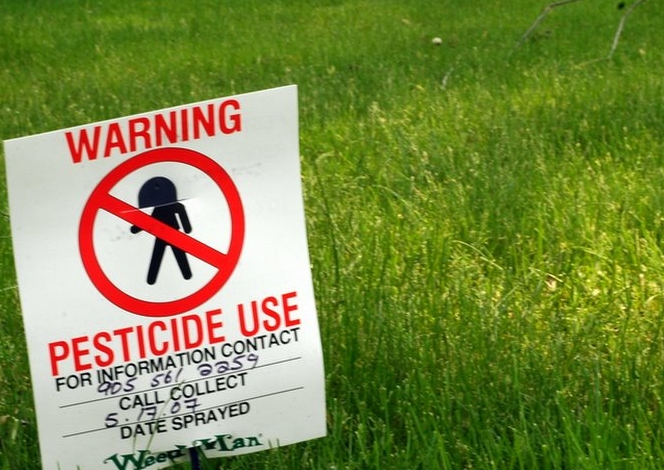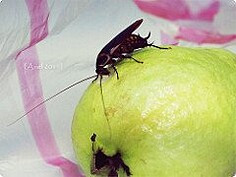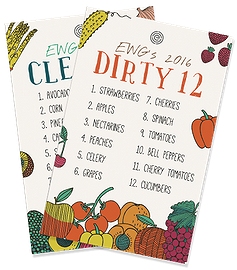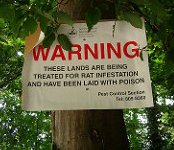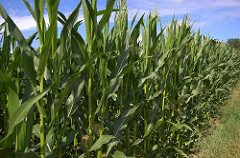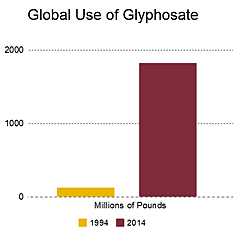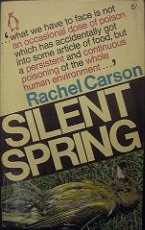|
The information on this page is adapted from toxipedia.org. To learn more about Toxipedia’s integration into our website, visit our Toxipedia webpage.
|
Pesticides kill unwanted organisms: animals, plants, fungi, microbes and more. The mechanisms by which they are able to kill may also be harmful to humans.
Pesticides are defined by the US Environmental Protection Agency as any substance intended for preventing, destroying, repelling or mitigating any pest. Though often misunderstood to refer to only to insecticides, the term pesticide also applies to herbicides, fungicides and various other substances to control pests.1 Hundreds of pesticides are registered under the US Federal Insecticide, Fungicide, and Rodenticide Act (FIFRA).2
Uses
Pesticides are used mainly in agriculture, but large quantities are also used in many other places:
| Site | Examples |
| Homes and gardens | Pest control or preservatives in home vegetable and fruit gardens and orchards, flower gardens, preservatives in wooden structures |
| Lawns and landscaping | Pest control on private lawns, golf courses, sports fields, parks, school grounds, church grounds, roadsides |
| Indoors | Insect control, rodent control, mold and mildew control, antimicrobial cleaners and clothing, flea sprays |
| Food | Disinfectants and preservatives, pest control applied to livestock |
| Bodies |
Insect repellents, disinfectants, antibiotics, lice treatments, preservatives in cosmetics |
An assessment in 1992 found that 85 percent of all US households have at least one pesticide in storage, and a survey the same year in Minnesota found that on a per-acre basis urban dwellers use herbicides for lawn care at rates equal to those used by farmers for food production.7
 |
| Data source: US Environmental Protection Agency;8 click to zoom |
Toxicity
Pesticides work by interfering with necessary biological mechanisms in pests. Because many organisms share similar biological mechanisms, the effects of pesticides often are not specific to one type of organism. Pesticides can kill their target pests but may also harm other organisms, including humans. Many pesticides are also considered endocrine disruptors (EDCs), noted for their effects on our endocrine systems, and/or persistent organic pollutants (POPs), noted for their longevity, toxicity to humans and animals, and ability to be transported around the globe through the atmosphere.
Human Health Effects
Acute Exposure (Poisoning)
In the United States, an average of more than 130,000 calls to poison control centers were reported from 2006 to 2010, with an average of more than 20,000 cases treated in health care facilities annually. The Agency for Healthcare Research and Quality reported an annual average of 7385 emergency room visits during 2006 to 2008, and 1419 annual hospitalizations during 2005 to 2009.9 Recent figures worldwide are elusive, but the WHO estimated in 1990 that there are around 3 million hospital admissions for pesticide poisoning each year, 2 million of which are as a result of deliberate ingestion, and these result in around 220,000 deaths. However, WHO also considered that "this necessarily reflects only a fraction of the real problem."10
Specific health effects and toxicity symptoms vary across both general classes of pesticides and individual pesticides within classes.
Organochlorine Pesticides
Health effects and symptoms following Ingestion:
- Loss of sensation around the mouth
- Hypersensitivity to light, sound, and touch
- Dizziness
- Tremors
- Nausea
- Vomiting
- Nervousness
- Confusion
Organophosphate or Carbamate Insecticides
Symptoms and health effects following exposure:
- Increased salivation
- Increased perspiration
- Narrowing of pupils
- Nausea
- Diarrhea
- Decrease in blood pressure
- Muscle weakness
- Fatigue
These symptoms can last up to a few days but decline as soon as acetylcholine levels return to normal in the body.
Pyrethroids
Symptoms and health effects following exposure:
- Allergic reactions
- Hyper-excitation
- Aggressiveness
- Incoordination
- Whole-body tremors
- Seizures
Other Pesticides
- Acute hepatocellular injury (hepatitis)
- Acute tubular necrosis
Long-term Health Impacts
Cancer
Carcinogenicity of some common pesticides, from PAN's Pesticides Database11 and CHE's Toxicant and Disease Database12 unless noted otherwise:
| Category | Known Carcinogens | Probable Carcinogens |
|
Fungicides |
Maneb and nickel sulfate hexahydrate | |
|
Herbicides and insecticides |
Arsenic and arsenic compounds |
Permethrin Organophosphates13 |
| Wood preservatives | Chromium VI compounds (hexavalent chromium) Creosote |
Reproductive and Developmental Effects
Pesticides linked to reproductive and developmental health impacts in summary.14 Specific associations, plus links with limited evidence, are listed in CHE's Toxicant and Disease Database. Information about more pesticides is available from Pesticide Action Network's Pesticides Database—Chemicals.
| Categories and Common Pesticides |
Strong Evidence |
Good Evidence |
|
Fungicides Hexachlorobenzene Vinclozolin |
Altered sex ratio Hormonal changes |
|
|
Herbicides |
|
Abnormal sperm Cognitive impairment Decreased coordination / dysequilibrium Fetotoxicity Low birth weight / small for gestational age / intrauterine growth retardation Menstrual disorders Seizures |
|
Insecticides Parathion |
Abnormal sperm Cognitive impairment Fetotoxicity Low birth weight Reduced male fertility |
Abnormal sperm Hormonal changes |
| Nematicides Ethylene dibromide Methyl bromide |
Abnormal sperm |
Cognitive impairment |
|
Wood preservatives |
Other Health Effects
Health associations for selected pesticides; information is from CHE's Toxicant and Disease Database15 unless noted otherwise.
| Pesticide | Strong Evidence | Good Evidence |
|
Aldicarb |
Peripheral neuropathy | Immune suppression |
| Carbamates | Arrhythmias Peripheral neuropathy |
Asthma - irritant Immune suppression |
|
Chlordane |
Immune suppression Peripheral neuropathy Porphyria (toxic) |
|
|
Chlordecone |
Peripheral neuropathy | |
|
Chlorpyrifos |
Immune suppression Psychiatric disturbances |
|
|
Creosote |
Hyperkeratosis / hyperpigmentation Leukoderma (hypopigmentation) |
|
|
DDT |
Chloracne | Hearing loss Peripheral neuropathy Porphyria (toxic) Psychiatric disturbances |
|
Diquat |
Pulmonary edema | |
|
Hexachlorobenzene |
Hyperkeratosis / hyperpigmentation Porphyria (toxic) |
|
| Maneb | Peripheral neuropathy | |
|
Methyl bromide |
Arrhythmias Peripheral neuropathy Psychiatric disturbances Pulmonary edema Spasticity / myoclonus |
|
|
Nicotine |
Behavioral problems | |
|
Paraquat |
Pulmonary edema Pulmonary fibrosis |
Chronic renal disease Parkinson's disease / movement disorders |
|
Pentachlorophenol (PCP) |
Aplastic anemia Chloracne Immune suppression |
|
|
Pyrinuron (Vacor)16 |
Type 1 diabetes | |
|
Propoxur |
Aplastic anemia | |
|
Pyrethroids |
Peripheral neuropathy Pneumonitis (hypersensitivity) |
Asthma allergen, sensitizer |
|
Thimerosal |
Contact dermatitis - irritant |
Sensitive and Vulnerable Populations
|
image from Wes Peck at Creative Commons; click to zoom |
As with many chemicals, fetuses and children are especially sensitive due to their continuing development. Brains, reproductive organs, and all other body systems are forming and growing, making them vulnerable to alterations. Pesticide use by parents before, during or after pregnancy can have long-term impacts on children, including birth defects, developmental disabilities, behavior and psychological effects, impaired reproductive function and cancer. Reviews have found that indoor pesticide exposure in childhood is associated with higher risk of leukemia and lymphoma,17 and occupational use of pesticides by parents is associated with a higher risk of brain tumors in children.18 An investigation in 2007 found that girls' exposure to DDT before age 14 increases their risk of breast cancer as adults five-fold. Girls exposed after age 14 did not have an increase compared to girls who were not exposed.19
Early indications of genetic susceptibility to exposures are found in studies of Parkinson's disease and cancer.20 See the Gene-Environment Interaction webpage for more information.
People who live near or work where pesticides are produced or applied are at increased risk for exposure.
Routes of Exposure
Remote ExposuresExposures can be several steps removed from the intended use of the pesticide. For example, pesticides applied to lawns could be picked up by a pet's fur, transferred to human hands and then to food, and finally ingested.
|
Typical routes of exposure are dermal (skin), inhalation and ingestion, but exposure through the eyes is also possible.
Dermal exposure is most common in work situations where workers mix, load or apply pesticides. Dermal exposure can also occur from touching an item or person contaminated with pesticide residue.
Inhalation and absorption through the lungs occurs through airborne particles from powders or droplets. Inhalation is especially likely with high pressure, volume or fogging equipment. The smaller the particles or droplets, the farther they can travel on air currents. Low pressure application, producing larger droplets, is less hazardous.
Ingesting large quantities of pesticides can result in the most harmful and serious poisonings. Pesticides can also be accidently ingested through accidental drinking from a mislabeled or reused pesticides container, which is why great care should be taken not to mix or store pesticides in food containers and to maintain and follow instructions on pesticide container labels.21
Low-level, often chronic pesticide ingestion occurs through resides on pesticide-treated foods. Initial studies have shown measurable, and sometimes dramatic, differences in pesticide residues in urine when a diet of pesticide-treated food sources is compared to an organic food diet.22
Reducing Exposures
Less Toxic Pest ControlVisit these sites for detailed information about controlling pests with methods and materials that are less toxic to children, pets and non-targeted wildlife:
image from Ariel Chang at Creative Commons |
In Lawn, Garden and Home
The most effective way to reduce pesticide exposures is to use them as little as possible. There are safer alternatives for every use of chemical pesticides, such as Integrated Pest Management (IPM) for your home and garden. In a nutshell, IPM prevents household pests naturally by removing their sources of food, water, and shelter and also their access to your home:
- Fix leaky plumbing and prevent wet spots inside and outside your home.
- Wipe up food residues on countertops.
- Seal pet food containers.
- Keep garbage contained and covered.
- Rinse recyclable containers.
- Remove woodpiles from around or inside your home.
- Repair door and window screens.
- Remove diseased plants and fallen fruit that may attract pests to your garden.
Wipe shoes on doormats and leave them at the door to avoid tracking in pesticide residues. Control dust, which can also contain pesticide residues in your home. Vacuum regularly with a HEPA filter vacuum if possible. Use damp dust rags instead of feather dusters which stir up dust and disperse it into the air.
If you do store pesticides at home, lock them away from children's reach. Keep toxics in the original containers and follow all warning label directions.
|
Environmental Working Group's Dirty Dozen and Clean 15 lists |
On Food
Always wash fruits and vegetables. Even after washing and cooking foods, pesticide residues may remain, so also peel fruits and vegetables when possible. Buy organically grown produce whenever you can, especially those foods most likely to contain chemical residues. See the Environmental Working Group's annual lists of the Dirty Dozen and Clean 15 foods.
In Lice Treatment
Prevent head lice from becoming unwelcome guests: see Head Lice Prevention from Healthline. If you do contract lice, avoid head lice treatments that contain lindane, especially with children or anyone weighing less than 110 pounds.23
At Work
|
image from Walmart at Creative Commons |
Follow all label instructions, including use of protective clothing and equipment. Measure, mix, apply and store pesticides as directed. Ventilate areas during use if recommended. Avoid use that will contaminate water or downwind neighborhoods. Clean up spills according to the manufacturer's instructions. Wash well after handling pesticides, and especially before handling food or eating. To avoid take-home exposures, leave contaminated clothing and gear at work if possible, and wash skin and hair thoroughly before going home or having physical contact with others. In case of an exposure, seek medical treatment promptly. If you suspect you are pregnant, take extra precaution or see if you can work away from pesticides if possible.24
In Your Community
|
image from Duca di Spinaci at Creative Commons |
Talk to neighbors, schools, businesses, and government officials about reducing pesticide use on playgrounds, lawns, roadsides, schools and other public areas.
Regulation
Worldwide
- Stockholm Convention on Persistent Organic Pollutants, 2001
- Food and Agriculture Organization of the United Nations: The International Code of Conduct on Pesticide Management and Guidelines on Highly Hazardous Pesticides
European Union
United States
- Federal Insecticide, Fungicide, and Rodenticide Act (FIFRA)
- Federal Food, Drug and Cosmetic Act (FFDCA)
- Food Quality Protection Act
- Pesticide Registration Improvement Act of 2003 (PRIA)
- Endangered Species Act (ESA)
Case Studies: Selected Pesticides
Here we highlight a few pesticides that have captured popular attention. They are not necessarily the most hazardous pesticides, but they have achieved some notoriety.
Agent Orange
The US military sprayed an estimated 20 million gallons25 of Agent Orange and other herbicides on trees and vegetation during the Vietnam War. Several decades later, concerns about the health effects from these chemicals continue.26 A mixture of the herbicides 2,4-D and 2,4,5-T, which was also contaminated with dioxin (TCDD), Agent Orange has been associated with these health impacts on the Vietnamese population:
- Birth defects27 including spina bifida,28 and elevated salivary and serum cortisol and cortisone levels.29
Effects in US veterans:
- Increased incidence of diabetes, heart disease, hypertension and chronic respiratory conditions30
- Good evidence of a link to cancer of the prostate and bladder and soft tissue sarcomas and B-cell lymphomas and also chloracne, and limited evidence of an association with Parkinson's disease; type 2 diabetes; hypertension, ischemic heart disease, and stroke; hypothyroidism; early onset peripheral neuropathy and porphyria cutanea tarda31
In 1969 the Federation of American Scientists submitted a petition to the White House with more than 5000 signatures of renowned scientists, including 17 Nobel laureates and 129 members of the National Academy of Sciences, to end the herbicide program. In April 1970, the US government restricted use of 2,4,5-T, and therefore Agent Orange, in both Vietnam and the US. In 1971 all the remaining stocks of Agent Orange were gathered and either shipped to Johnston's Island in the South Pacific or shipped and stored at the Seabees base in Gulfport, Mississippi, from which they were destroyed by an incinerator ship in September 1977.32
Atrazine
|
image from Daniel_Bauer at Creative Commons |
Atrazine is one of the most widely used herbicides in the US, with an estimated 70 million pounds used in agriculture in 2014, a majority on corn crops.33 Sampling by the US Geological Survey has found atrazine in about 90 percent of streams and more than 40 percent of groundwater in agricultural areas, and also in about 70 percent of streams and about 35 percent or groundwater in urban areas.34 It has been found in surface water used for public water supplies in the Midwest at levels greater than the standards established by the Environmental Protection Agency.35
Health concerns associated with atrazine include birth defects36 and its endocrine-disrupting potential to cause mammary gland tumors in rodents and alter male reproduction.37
Atrazine's use has been banned since 2003 in the European Union and Switzerland due to concerns that it contaminates groundwater.38
DDT
Hailed as the “wonder insecticide of World War II” for protecting troops from typhus and malaria, DDT (dichlorodiphenyltrichloroethane) is an organochloride insecticide that was widely used worldwide from the mid-1940s through the 1960s. Serious concerns about its impact on human health and the environment led the US EPA to issue a cancellation order for DDT in 1972. Use in the US and in most countries was discontinued, but because it was widely used, because it persists in the environment without breaking down, and because it bioaccumulates in fat tissue, residues are still a concern and exposures ubiquitous.39 A 2002 review went so far as to state that “there is not a single living organism that doesn’t contain DDT."40 DDT has been detected in the Arctic, far from any production or use, and in food from all over the world.41
|
American GI spraying DDT in an Italian home, 1945; image from Otis Historical Archives National Museum of Health and Medicine at Creative Commons |
Although DDT use is banned under the Stockholm Convention on Persistent Organic Pollutants, an exemption is granted for vector control of malaria and other insect-borne diseases, primarily in India, China and sub-Saharan Africa.42
DDT has been associated with cancer in laboratory animals, but no clear evidence has emerged in humans.43 Based on all the available evidence, the US Department of Health and Human Services has determined that DDT is reasonably anticipated to be a human carcinogen, the International Agency for Research on Cancer (IARC) has determined that DDT is possibly carcinogenic to humans and US EPA has determined that DDT is a probable human carcinogen.44
As an endocrine disruptor, DDT and its metabolite DDE have endocrine effects particularly during development, as demonstrated in animal tests. It can disrupt natural hormone signaling by binding to androgen receptors and blocking signals in cells, causing reproductive and developmental effects. Studies in humans suggest that high DDT/DDE burdens may be associated with hormonally controlled endpoints such as duration of lactation, fertility and maintenance of pregnancy. High blood levels of DDE during pregnancy have also been associated with increased odds of having preterm infants and small-for-gestational-age infants. Perinatal exposure of animals to DDT/DDE has caused alterations in the reproductive organs and infertility. In animals, DDT/DDE can produce embryotoxicity, fetotoxicity, and abnormal development of the sex organs. Adult mice administered DDT early in life showed neurobehavioral alterations when tested later in life.45
Glyphosate
First introduced in 1974 under the trade name Roundup (but since also sold as Accord, Rodeo, Touchdown and other products), glyphosate is a very popular nonselective herbicide, used both in agriculture and on lawns and gardens. It is one of the world’s most widely used broad-spectrum herbicides and accounts for around 25 percent of the global herbicide market.48
Use of glyphosate-based herbicides (GBHs) can result in residues of glyphosate and its primary metabolite AMPA in crops at harvest and in processed foods. With the huge amount of GBHs used worldwide, exposures have become common in the food supply. A 2016 consensus statement on the risks of glyphosate exposure summarizes concerns:
- Damage to the liver and kidneys
- Cancer; the International Agency for Research on Cancer (IARC) has classified glyphosate as "probably carcinogenic to humans." However, an extensive review by the European Food Safety Authority in 2015 concluded that "glyphosate is unlikely to pose a carcinogenic hazard to humans."49
- Congenital malformations in pigs fed glyphosate-contaminated feed, causing concern regarding similar human birth defects observed in populations living in and near farming regions.50
History & Ethics
Early Pesticides
Pesticides have been used in different forms since about 1000 BC when the Chinese used sulfur as a way to control bacteria and mold. Sulfur is still used in many fungicides to control diseases in plants, to kill off unwanted bacteria in wine barrels and to remove unwanted yeast from wine. In addition to sulfur, the Chinese also utilized arsenic as both an insecticide and herbicide, and its use continues even now. See the Arsenic webpage.
Plant-produced pesticides include nicotine, pyrethrums from chrysanthemums and rotenone from the root of the Derris elliptica plant. These pesticides have been used to in kill insects and fish, with substantial use beginning in the late seventeenth century. Nonsynthetic pesticides are often difficult to purify and produce in large qualities.
The regulation of pesticides by the federal government began in 1910 with the passage of the Federal Insecticide Act by Congress. This legislation ensured quality pesticides by protecting farmers and consumers from fraudulent and/or adulterated products by manufacturers and distributors.51
Synthetic Pesticides
In 1939 a Swiss Chemist named Paul Muller discovered that DDT, first synthesized in 1873, was a potent insecticide.52 By 1945 it had become the most widely used pesticide in the world, both in commercial agriculture and also in combatting insect-borne illness such as malaria and typhus. Muller won the Nobel Prize in 1948 for DDT's development as an insecticide.53
Throughout the 1940s and 1950s, many new pesticides were created and marketed, including the class of organophosphates such as insecticides parathion and malathion, plus 2,4-D and carbamates.54 Some pesticides, such as organophosphorus compounds, can also serve as chemical warfare agents,55 and thus military interest promoted development.
In 1947, the Federal Insecticide, Fungicide, and Rodenticide Act (FIFRA) was passed. This act extended the coverage of the Federal Insecticide Act to include herbicides and rodenticides and required that all pesticide products be registered with the USDA before their sale in interstate or foreign commerce.56
|
image from Frank Hebbert at Creative Commons |
During the 1960s, Monsanto developed an herbicide named Agent Orange, used widely by the United States during the Vietnam War.
Concerns Increase
In 1962 Rachel Carson’s book Silent Spring brought substantial attention to the harmful effects of several pesticides—including chlordane, heptachlor, dieldrin, aldrin, endrin, parathion, malathion and DDT—on humans, animals and the environment. This book both raised awareness and concern over pesticides' harmful effects on wildlife and humans and is credited with launching the environmental movement and awareness of the connections between environmental and human health.
In 1972, prompted by studies that determined continued massive use of DDT posed unacceptable risks to the environment and human health, the United States banned DDT, making its use in domestic agriculture and trade illegal.57 This was widely viewed as spurred by Rachel Carson's 1962 book.
Also in 1972, the Environmental Protection Agency was created with the authority to regulate pesticides after weighing costs and benefits and evaluating risks. The 1996 amendment to the Federal Insecticide, Fungicide, and Rodenticide Act (FIFRA) mandated that all pesticides distributed or sold in the United States be registered (licensed) by EPA.58
The 1996, the Food Quality Protection Act amended FIFRA, requiring that special consideration be given to children’s exposure by using an additional tenfold safety factor when setting and reassessing tolerances.59
In 1998 the called on exporters of pesticides to use proper labeling and instructions for safe use on all products. This was one of the first international efforts to regulate hazardous chemicals/pesticides.60
In 2001 the Stockholm Convention on Persistent Organic Pollutants, an international United Nations treaty, called for international action and cooperation on the restriction and elimination of 12 POPs determined to be hazardous, including pesticides aldrin, chlordane, DDT, dieldrin, endrin, heptachlor, hexachlorobenzene (HCB), mirex and toxaphene. This treaty has been ratified by 180 nations worldwide.
Ethics Concerns
There's no question that pesticide use has saved hundreds of millions of lives: deaths from malaria dropped from 3.1 million worldwide in 1900 to fewer than 1.1 million in 1997, largely due to pesticide use against mosquitos. The gains are even more impressive if sub-Saharan Africa is excluded from the data, for malaria there has remained much more intractable than elsewhere. In the rest of the world, the percentage of deaths from malaria fell 99 percent from 1900 to 1997, from 8 percent of all deaths to 0.08 percent.61
Other types of pesticides are also important in safeguarding human health. Preservatives in food and cosmetics prevent bacterial growth that can lead to infection, illness, disability and even death.62
However, pesticide use comes with a price. Because pesticide use has not only the potential but an established history of contaminating the food, water, soil and air on which all humans depend, their use impacts all humankind. The application of chemicals that cause death when used inappropriately and that degrade our health even when used appropriately needs high scrutiny and constant oversight. The almost giddy enthusiasm for their development and use following World War II seems now to have been short-sighted. The effective lifetime of many pesticides—the time until their targeted pests develop immunity or resistance—might be measured in decades or less. Insect resistance to DDT and other insecticides was evident by 1970, for example.63 However, the toxic effects on human health persist for many generations. The benefits of pesticide use must be carefully weighed against their costs to current and future residents of Earth, both human and otherwise.
See more about pesticides and health in the list of CHE publications and Dig Deeper resources in the right sidebar.
This page was last revised by Nancy Hepp and student intern Eva Bauer in August 2016.
CHE invites our partners to submit corrections and clarifications to this page. Please include links to research to support your submissions through the comment form on our Contact page.
* header image from Aqua Mechanical at Creative Commons



